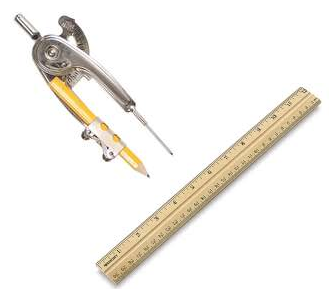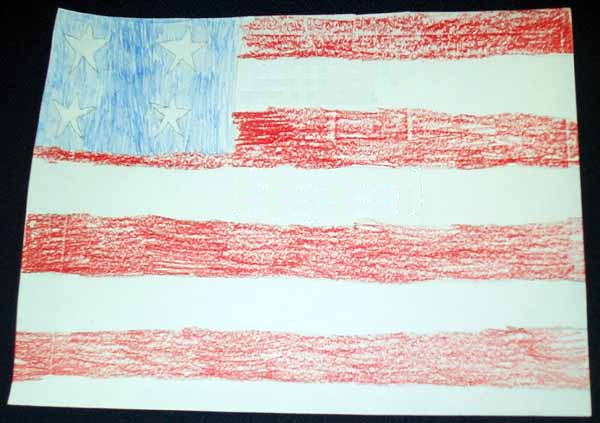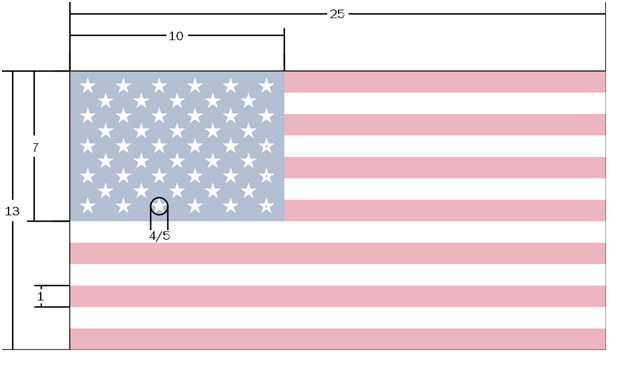How to Draw the United States Flag with Correct Proportions
One of the hallmarks of a well designed flag is that it can be easily drawn. While the United States flag is beautiful and has a design that is easily recognized, some of its exact proportions are difficult to remember or duplicate. It is a simple task for a school child to draw the U.S. flag, and the product will assuredly have red and white stripes with a blue union containing white stars. However, the number of stripes and the number of stars may vary, and yet the drawing will be recognized without difficulty.
The exact proportions of the flag are not found in the law describing the United States flag. It simply states:
The flag of the United States shall be thirteen horizontal stripes, alternate red and white; and the union of the flag shall be forty-eight [now fifty] stars, white in a blue field. (Section 1, Title 4, U.S. Code)
More detailed proportions of the flag are spelled out in the Executive Order issued when Hawaii became a state (Executive Order 10834, by Dwight D. Eisenhower, on August 21, 1959 ). It measures all the elements found on the U.S. flag given in ratio to the width or hoist of the flag.
Older students and adults should know that there are thirteen stripes and fifty stars, but they would undoubtedly be unable to reproduce other details of the flag’s basic design. For example:
- How are the fifty stars arranged in the Union? Five rows of ten stars each? Seven rows of seven stars with the fiftieth star added to one of the horizontal rows? Actually, there are five rows of six stars each (30 stars) staggered with four rows of five stars each (20 stars); 30 stars pus 20 stars add up, of course, to the correct number of 50 stars.
- How many stripes wide is the union? Five or six? Actually, the union’s width is a little more than ½ of the flag’s width. Since the flag is 13 stripes wide, the union is 7 stripes wide which is slightly wider than ½ of the flag’s width (0.54 of the hoist).
- How long is the flag supposed to be? One and one half time the width? One and two fifths time the width? Or perhaps two times the width? The Presidential Executive Order specifies an exact length of one and nine tenths of the hoist. Although flag makers do not strictly follow that prescribed length for civilian flags, flags following government specifications are purchased by Federal Government agencies which do require flags to be made following the exact measurements specified in the Executive Order.
- How long is the union in relationship to the flag’s length? One third or one half of the length? Although the length of the union is usually described in a ratio to the hoist of the flag (0.76 of the hoist), it is actually two fifths of the flag’s length.
- How large are the stars supposed to be? Again the diameter of the stars is usually described in ratio to the width of the flag (0.0616 of the width); however that is a pretty unwieldy number to work with. For example a flag measuring three feet in width, would have stars measuring precisely 2.2176 inches in diameter. That reads two and two thousand one hundred and seventy-six ten thousandths of an inch. Flag makers would have to get out their slide rules for that one.
I would seem that there must be an easier way. Actually, if you want to draw the flag to the exact measurement specified by President Eisenhower’s Executive Order, all of the measurements can be easily converted to measure the flag by the width of the stripes. This may round the decimal numbers used in the Presidential Executive Order slightly, but measuring by the width of stripes is actually more exact and easier to use. Using the width of the stripes as the basic unit of measurement, a flag with a one inch wide stripes measures 13 stripes wide by 25 stripes long or 13 inches by 25 inches. Want a bigger flag? A two inch wide stripe yields a flag measuring 26 inches by 50 inches; a stripe measuring three inches creates a flag measuring 29 inches by 75 inches; and so on. See the chart below for exact measurements of the U.S. flag using the width of the stripes as the basic unit of measurement.
But, how do you draw a star to an exact size? You can Betsy Ross’ method of folding a piece of paper and creating a five-pointed star with one snip of the scissors (see prior flag-post.com entry “Stars in Their Eyes.” In our next flag-post.com article, we will consider how to draw a perfect five-pointed star of any diameter using a compass and a ruler, although some may prefer to simply use a protractor and divide a circle into five 72° segments. Connect those five points in the right way, and you have a five-pointed star. Easy if you know how, and we will show how to do it in the next flag-post.com.

It is easy to draw a five-pointed of any size star using a compass and ruler. Check the next flag-post.com to find out how.


